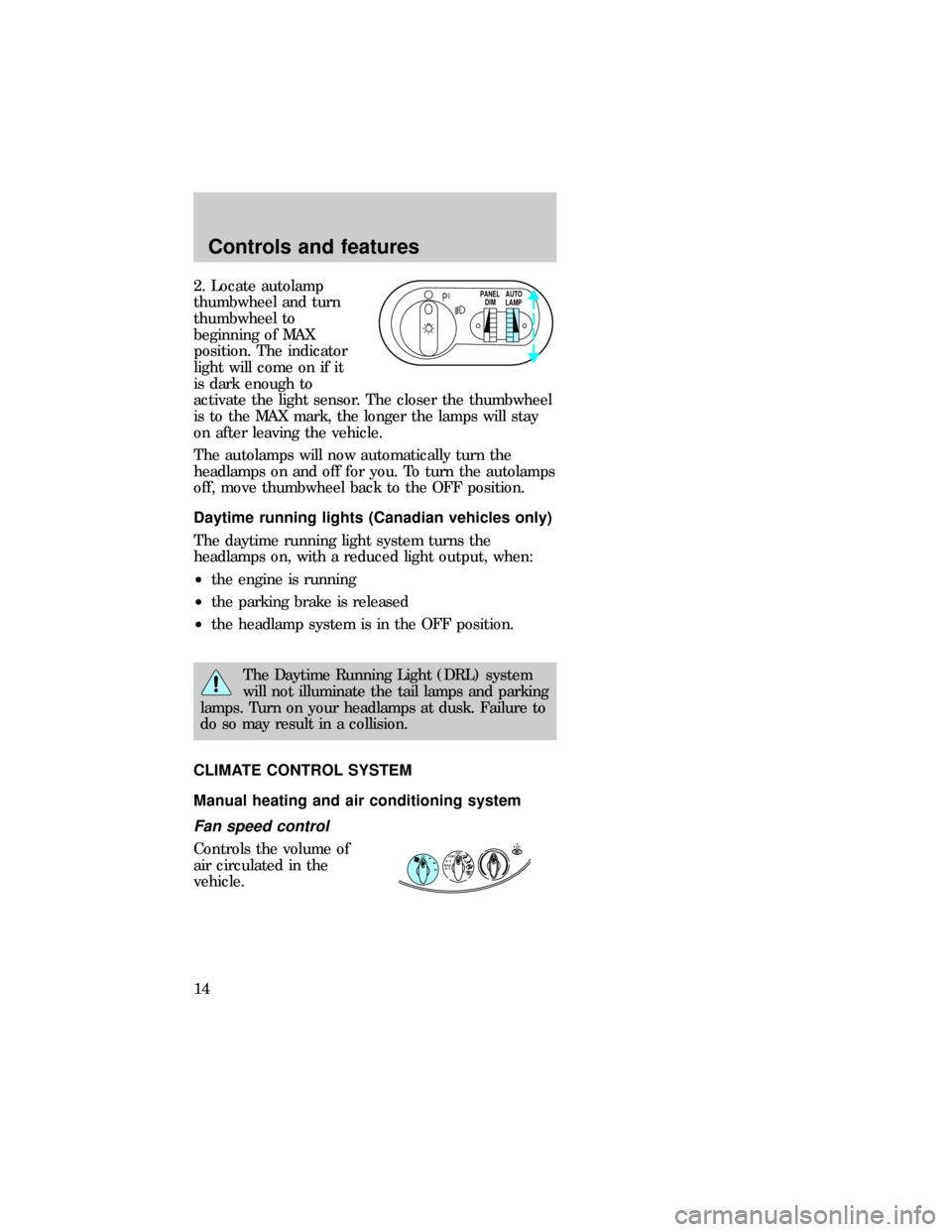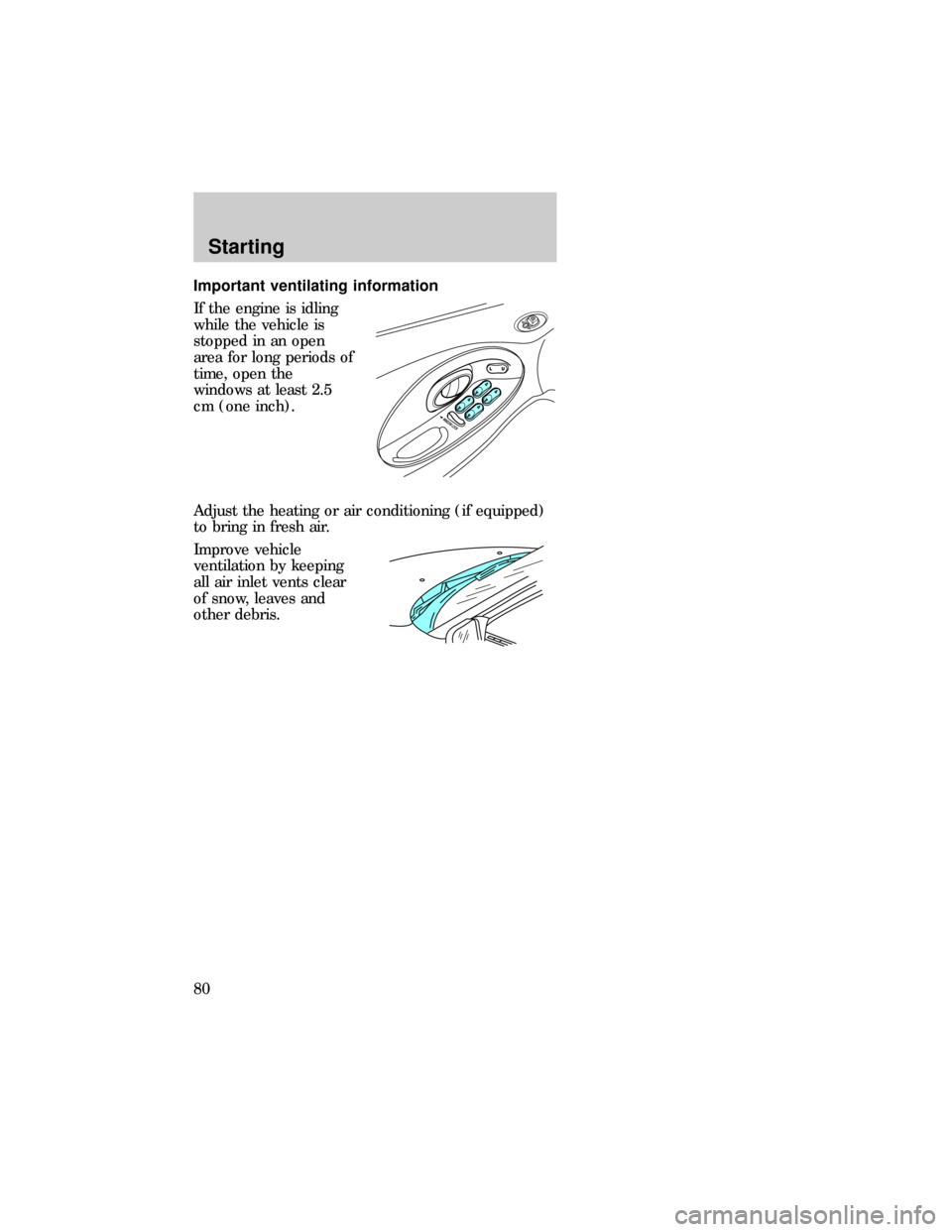air condition Mercury Sable 1997 Owner's Manuals
[x] Cancel search | Manufacturer: MERCURY, Model Year: 1997, Model line: Sable, Model: Mercury Sable 1997Pages: 167, PDF Size: 1.59 MB
Page 14 of 167

2. Locate autolamp
thumbwheel and turn
thumbwheel to
beginning of MAX
position. The indicator
light will come on if it
is dark enough to
activate the light sensor. The closer the thumbwheel
is to the MAX mark, the longer the lamps will stay
on after leaving the vehicle.
The autolamps will now automatically turn the
headlamps on and off for you. To turn the autolamps
off, move thumbwheel back to the OFF position.
Daytime running lights (Canadian vehicles only)
The daytime running light system turns the
headlamps on, with a reduced light output, when:
²the engine is running
²the parking brake is released
²the headlamp system is in the OFF position.
The Daytime Running Light (DRL) system
will not illuminate the tail lamps and parking
lamps. Turn on your headlamps at dusk. Failure to
do so may result in a collision.
CLIMATE CONTROL SYSTEM
Manual heating and air conditioning system
Fan speed control
Controls the volume of
air circulated in the
vehicle.
PPANEL
DIMAUTO
LAMP
R-DEFLO
HIOFF
A/C
MAX
A/CVENT
dno_drl
dno_climate-control-system
dno_manual-air-conditioning
Controls and features
14
Page 15 of 167

Mode selector control
Controls the direction
of the airflow to the
inside of the vehicle.
²MAX A/C - Uses recirculated air to cool the
vehicle. It allows for faster cooling but is noisier
than A/C. The air conditioning compressor will
operate in this mode.
²A/C - Uses outside air to cool the vehicle. It is
quieter than MAX A/C but not as economical. The
air conditioning compressor will operate in this
mode.
²VENT - Distributes outside air through the
instrument panel registers.
²OFF - Outside air is shut out and the fan will not
operate.
²
(Panel and floor) - Distributes outside air
through the instrument panel registers and the
front and rear floor ducts. The air conditioning
compressor will operate in this mode.
²
(Floor) - Allows for maximum heating. The
airflow is from the front and rear floor ducts.
²
(Floor and defrost) - Distributes outside air
through the floor ducts and the windshield
defroster ducts. The air conditioning compressor
will operate in this mode.
²
(Front defrost) - Distributes outside air
through the windshield defroster ducts. It can be
used to clear ice or fog from the windshield. The
air conditioning compressor will operate in this
mode.
Temperature control knob
Turn the dial to the
desired mix of warm
(red) and cool (blue)
air.
R-DEFLO
HIOFF
A/C
MAX
A/CVENT
R-DEFLO
HIOFF
A/C
MAX
A/CVENT
Controls and features
15
Page 16 of 167

Operating tips
²In humid weather, selectbefore driving. This
will prevent your windshield from fogging. After a
few minutes, select any desired position.
²To prevent humidity buildup inside the vehicle,
don't drive with the climate control system in the
OFF position.
²Don't put objects under the front seat that will
interfere with the airflow to the back seats.
²Remove any snow, ice or leaves from the air
intake area (at the bottom of the windshield
under the hood) on the passenger side of your
vehicle.
²If the air conditioner works well in MAX A/C but
not in A/C, this may indicate that the passenger
compartment air filter (if equipped) needs to be
replaced.
Electronic Automatic Temperature Control
(EATC) system (if equipped)
The EATC system will maintain a selected
temperature and automatically control airflow. You
can override automatic operation with any of the six
override controls at the bottom of the control panel.
TEMP
—+OFFAUTO
TEMPOUT
SIDEA/C MAXF-DEF
R-DEF
AUTO
VENT
F—+
dno_temp-control
Controls and features
16
Page 18 of 167

Changing modes (Temperature conversion)
Press MAX A/C and
the
F-DEF button
at the same time to
switch between
Fahrenheit and Celsius.
If the battery is
disconnected, the
display will revert to
Fahrenheit.
(fan speed)
Once AUTO is pressed, fan speed is adjusted
automatically for existing conditions.
You can override
automatic fan speed (at
any time) by pressing
FAN. The display
window will show FAN
and a series of dots
indicating fan speed. To
return to automatic fan
control, press AUTO.
Manual override controls
The override controls are located on the bottom of
the EATC and allow you to determine where airflow
is directed. To return to full automatic control, press
AUTO.
²MAX A/C - Uses recirculated air to cool the
vehicle. The temperature will display 16ÉC
TEMP
—+OFFAUTOTEMPOUT
SIDEA/C MAXF-DEF
R-DEF
AUTO
VENT
A/C
F—+
TEMP
—+OFFAUTOTEMPOUT
SIDEA/C MAXF-DEF
R-DEF
AUTO
VENT
—+
F—+
TEMP
—+OFFAUTO
TEMPOUT
SIDEA/C MAXF-DEF
R-DEF
AUTO
VENT
F—+
Controls and features
18
Page 19 of 167

(60ÉF).To exit, press AUTO or any of the other
override controls. MAX A/C is noisier but more
economical than A/C. The airflow will be from the
instrument panel registers. The air conditioning
compressor will operate in this mode.
²VENT - Distributes outside air through the
instrument panel registers. However, the air will
not be cooled below the outside temperature.
²
(Panel and floor) - Distributes outside air
through the instrument panel registers and the
front and rear seat floor ducts. The air will be
heated or cooled based on temperature selection.
The air conditioning compressor will operate in
this mode.
²
(Floor) - Allows for maximum heating
through the front and rear seat floor ducts.
²
(Floor and defrost) - Distributes outside air
through the floor ducts and the windshield
defroster ducts. If the outside temperature is
about 10ÉC (50ÉF) or higher, the air conditioner
will dehumidify the air to prevent fogging. The air
conditioning compressor will operate in this mode.
²
F-DEF (Defrost) - Distributes outside air
through the windshield defroster ducts. It can be
used to clear ice or fog from the windshield. If the
outside temperature is about 10ÉC (50ÉF) or
higher, the air conditioner will dehumidify the air
to prevent fogging. The air conditioning
compressor will operate in this mode.
²OFF - Outside air is shut out and the fan will not
operate.
Displaying outside temperature
²OUTSIDE TEMP - Outside air temperature will be
displayed. If the EATC is off, the display will go
blank after four seconds. If the EATC is on, the
display will show the outside temperature until
the button is pressed again.
Controls and features
19
Page 20 of 167

The outside temperature reading is most accurate
when the vehicle is moving. Higher readings may be
obtained when the vehicle is not moving. The
readings that you get may not agree with
temperatures given on the radio due to differences
in vehicle and station locations.
Operating tips
²In humid weather, selectF-DEF before
driving. This will prevent your windshield from
fogging. After a few minutes, select any desired
position.
²To prevent humidity buildup inside the vehicle,
don't drive with the climate control system in the
OFF position.
²Don't put objects under the front seat that will
interfere with the air circulation to the back seats.
²Remove any snow, ice or leaves from the air
intake area (at the bottom of the windshield
under the hood) on the passenger side of your
vehicle.
²If the air conditioner works well in MAX A/C but
not in A/C, this may indicate that the passenger
compartment air filter (if equipped) needs to be
replaced.
Rear window defroster and heated outside rear
view mirrors
The defroster clears
away fog, frost and
thin ice from the rear
window and outside
rear view mirrors.
Clear away snow from rear window and mirrors. The
defroster operates for 10 minutes then shuts off. If
more defrosting is required, press the control again.
R-DEF
dno_defroster
dno_rear-wiper
Controls and features
20
Page 63 of 167

If the air bag is inflated,the air bag will
not function again and must be replaced
immediately. If the air bag is not replaced, the
unrepaired area will increase the risk of injury in a
collision.
The SRS consists of:
²driver and passenger air bag modules (which
include the inflators and air bags),
²one or more impact and safing sensors,
²a readiness light and tone
²and the electrical wiring which connects the
components.
The diagnostic module monitors its own internal
circuits and the supplemental air bag electrical
system readiness (including the impact sensors), the
system wiring, the air bag system readiness light, the
air bag back up power and the air bag ignitors.
DETERMINING IF THE SYSTEM IS
OPERATIONAL
The SRS uses a readiness light in the instrument
cluster or a tone to indicate the condition of the
system. Refer to theAir bag readinesssection in
theInstrumentationchapter. Routine maintenance
of the air bag is not required.
A difficulty with the system is indicated by one or
more of the following:
²The readiness light
will either flash or
stay lit.
²The readiness light
will not illuminate immediately after ignition is
turned on.
²A group of five beeps will be heard. The tone
pattern will repeat periodically until the problem
and light are repaired.
com_determing_operational.01
Seating and safety restraints
63
Page 80 of 167

Important ventilating information
If the engine is idling
while the vehicle is
stopped in an open
area for long periods of
time, open the
windows at least 2.5
cm (one inch).
Adjust the heating or air conditioning (if equipped)
to bring in fresh air.
Improve vehicle
ventilation by keeping
all air inlet vents clear
of snow, leaves and
other debris.
Starting
80
Page 94 of 167

Driving while you tow
Do not drive faster than 72 km/h (45 mph) with any
weight on the trailer while towing on a hot day or in
hilly country.
Cruise control may shut off if you are towing on
long, steep grades.
When towing a trailer:
²Use 2 (Second) (if equipped) or 1 (First) when
towing up or down steep hills. This will eliminate
excessive downshifting and upshifting for
optimum fuel economy and transaxle cooling.
²Anticipate stops and brake gradually.
Servicing after towing
If you tow a trailer for long distances, your vehicle
will require more frequent service intervals. Refer to
theService Guidefor more information.
Trailer towing tips
²Practice turning, stopping and backing up in an
area before starting on a trip to get the feel of the
vehicle trailer combination. When turning, drive
slightly beyond the normal turning point so the
trailer wheels will clear curbs and other obstacles.
²Allow more room for stopping with a trailer
attached.
²The trailer tongue weight should be 10±15% of
the loaded trailer weight.
²After you have traveled 80 km (50 miles),
thoroughly check your hitch, electrical
connections and trailer wheel lug nuts.
²When stopped in traffic for long periods of time in
hot weather, place the gearshift in P (Park) and
increase idle speed. This aids engine cooling and
air conditioner efficiency.
²Vehicles with trailers should not be parked on a
grade. If you must park on a grade, place wheel
chocks under the trailer's wheels.
dno_towing-tips
com_fuel_consumption.01
Driving
94
Page 136 of 167

engine will perform adequately on other gasolines,
the performance of the emission control devices and
systems may be adversely affected. Repair of
damage caused by using a fuel that your vehicle was
not designed for may not be covered by your
warranty.
Octane recommendations
Your vehicle is
designed to use regular
gasoline with an
(R+M)/2 octane rating
of 87. We do not
recommend gasolines
labeled as ªregularº in
high altitude areas that
are sold with octane
ratings of 86 or even less.
Do not be concerned if your vehicle sometimes
knocks lightly. However, if it knocks heavily under
most driving conditions on the recommended octane
fuel, see your dealer or a qualified service technician
to prevent any engine damage.
Fuel quality
If you are experiencing starting, rough idle or
hesitation problems try a different brand of fuel. If
the condition persists, see your dealer or a qualified
service technician.
The American Automobile Manufacturers Association
(AAMA) issued a gasoline specification to provide
information on high quality fuels that optimize the
performance of your vehicle. We recommend the use
of gasolines that meet the AAMA specification if
they are available.
It should not be necessary to add any aftermarket
products to your fuel tank if you continue to use a
high-quality fuel.
87
com_octane_recommendations.01
com_fuel_quality.01
com_cleaner_air.01
Maintenance and care
136